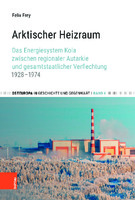Arktischer Heizraum
Das Energiesystem Kola zwischen regionaler Autarkie und gesamtstaatlicher Verflechtung 1928–1974
Author(s)
Frey, Felix
Collection
Knowledge Unlatched (KU); Swiss National Science Foundation (SNF)Number
104875Language
GermanAbstract
Die Halbinsel Kola im Nordwesten Russlands stellte die sowjetische Verwaltung vor ein Energieproblem. Kola war zwar reich an Bodenschätzen, verfügte jedoch über keine fossilen Brennstoffe. Wie die Region mit Energie zu versorgen sei, war über Jahrzehnte ein Verhandlungsgegenstand.
Sowjetische Botaniker forschten auf der Halbinsel Kola an einer arktistauglichen Kartoffel. Zur selben Zeit entstanden Wasserkraftwerke jenseits des Polarkreises; Kumpel förderten Kohle in gefrorenen Minen. Diese Bemühungen der 1930er Jahre verband ein Leitgedanke: Die Energieversorgung jeder sowjetischen Region sollte eigenständig sein.
Nach 1945 wich diese Maxime vermehrt überregionalen Interdependenzen. Kola verband sich durch Hochspannungsleitungen, Brennstoffeinfuhr und internationale Kraftwerkprojekte immer stärker mit fernen Landschaften. Regionale Autarkie und gesamtstaatliche Verflechtung waren Grundgedanken sowjetischen Verwaltungshandelns, dessen Erbe nicht nur im Energiesektor bis heute nachwirkt.
Keywords
History; Nordosten; Russland; Murmansk; Energiegeschichte; Zeitgeschichte; HIS037070; HIS032000; HBJQDOI
10.7788/9783412515065ISBN
9783412515065OCN
1135845388Publication date and place
Köln, 2019Grantor
Imprint
BöhlauClassification
History and Archaeology
20th century, c 1900 to c 1999


 Download
Download Web Shop
Web Shop